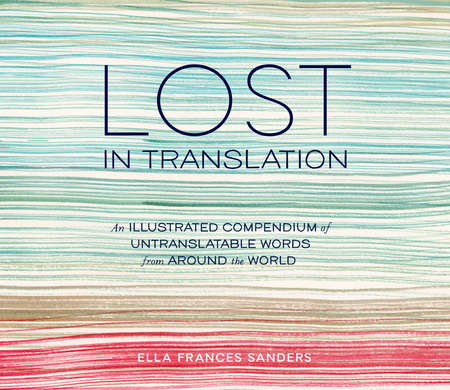 Lately I’ve been receiving a lot of review copies of novelty books. I wanted to review Crap Taxidermy, a self-explanatory photo book based on a Tumblr, but it depressed me too much. Lost in Translation: An Illustrated Compendium of Untranslatable Words from Around the World is much more my style, although it too has a Tumblr feel about it, and my feelings on bloggy books are mixed. Unrelated to the movie of the same name, Lost in Translation is a collection of foreign words that have no equivalent in English.
Lately I’ve been receiving a lot of review copies of novelty books. I wanted to review Crap Taxidermy, a self-explanatory photo book based on a Tumblr, but it depressed me too much. Lost in Translation: An Illustrated Compendium of Untranslatable Words from Around the World is much more my style, although it too has a Tumblr feel about it, and my feelings on bloggy books are mixed. Unrelated to the movie of the same name, Lost in Translation is a collection of foreign words that have no equivalent in English.
The Set Up
On the right side of each page, the foreign word is displayed in a hand-drawn font with a stylized illustration reminiscent of the Notegraphy app. It is accompanied by a dictionary definition. On the left side, the author adds a short reflection on the word; it is more poetic than expository. This is followed by identification of the source language (some of which I’ve never even heard of – Wagiman? Tulu?) and part of speech.
The book does not alphabetize the words or group them by language. Lost in Translation is less a reference than a piece of art, and it is a lovely one. Of course, I went straight for the Icelandic entry:
Tíma – verb, Not being ready to spend time or money on a specific thing, despite being able to afford it.
Language as Culture
I looked for Icelandic first because Iceland has the culture I am most interested in understanding right now. Language is not just interchangeable vocabulary. It is a reflection of who we are as a culture, what we value and how we understand the world. In turn, language shapes those things for us. When we don’t have words for something, we have a harder time understanding it. This is one of the reasons that multilingual people are at such an advantage in the world. Not only can they communicate with more people, they actually have an extra set of tools for understanding the world.
On the one hand, Lost in Translation is a cute novelty book. It’s a safe gift for a co-worker or waiting room reading. But on the other hand, flipping through the book, one can’t help wondering about the people who would develop a seven-syllable word to describe the wordless experience of two people mutually understand that they want the same thing, but who are each unwilling or unable to initiate action towards it. Doesn’t it seem as if understanding the origin of the word Mamihlapinatapai could unlock an understanding of the indigenous Chilean people who speak Yaghan? And isn’t that sort of musing exactly what art is supposed to accomplish?



About the author